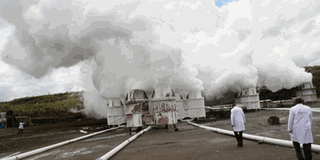Geothermal firm told to hasten power generation at Menengai

Geothermal Development Company engineers monitor activities at a geothermal well at the Menengai geothermal field in Nakuru on November 10, 2014. FILE PHOTO | SULEIMAN MBATIAH | NATION MEDIA GROUP
What you need to know:
- The eight –year –old State Corporation is supposed to contribute 810MW towards this target out of which 460MW are to be generated from Menengai fields.
- The remaining balance of 150MW will be generated from Suswa and an additional 200MW from Silale project in Baringo County.
- The drilling of the Menengai fields started in 2011 but so far GDC has managed to generate 105 MW which is yet to be added to the national grid.
A senior official at the Vision 2030 secretariat wants the Geothermal Development Company (GDC) to fast-track the process of generating steam power at the Menengai fields in Nakuru County.
This, he said, will speed up the country’s ambitious flagship project of providing Kenyans with green energy and at the same time save the multibillion-shilling project from being branded another “white elephant project.”
According to the Vision 2030 road map, the Menengai field is one of the key pillars of the 5,000MW that the country aims to generate.
The eight–year–old State corporation is supposed to contribute 810MW towards this target, out of which 460MW are to be generated from the Menengai fields.
The remaining balance of 150MW will be generated from Suswa and an additional 200MW from the Silale project in Baringo County.
The drilling of the Menengai fields started in 2011, but so far GDC has managed to generate only 105 MW, which are yet to be added to the national grid.
The delay, according to the company, was prompted by Independent Power Producers, who have not completed building power plants at the site.
TECHNICAL ISSUES
GDC is expected to generate Sh1.7 billion annually from the sale of steam in the Menengai fields when the power plants become operational in 2017.
“We were supposed to celebrate the inclusion of 105MW from [the] Menengai wells in the national grid last Christmas, but this has been delayed,” said Jonathan Lodompui, a director at the Kenya Vision 2030 secretariat.
Mr Lodompui said the secretariat has advised GDC to sort out the pending technical issues and avoid further delays.
“We are going to extend more time to GDC to resolve the outstanding technical issues slowing down the generation of power at [the] Menengai wells and hopefully they will stick to the new timelines,” he added.
However, he did not indicate the time frame, only saying ,“We have discussed this issue internally with GDC management and we have advised them accordingly.”
Mr Lodompui said the ball is now in the court of Independent Power Producers to take up the challenge and turn the multibillion-shilling project into a thriving power-generation hub in the country.
He was speaking in Nakuru town when he led a team from the Vision 2030 secretariat who were inspecting the environmental strategic impact assessment initiatives at the site by the company.
BEST PRACTICES
According to Sabine Rundgren, the project officer in charge of climate change at the Hanns Seidel Foundation, the agency is targeting flagship projects under Vision 2030 to ascertain how Kenya was utilising sources of green energy.
“We are looking at the best practices within this environmentally friendly projects and how the country and the communities living near the project are benefiting,” said Ms Rundgren.
She said apart from monitoring the implementation of the projects, her foundation is also assessing the effects of climate change and the mitigation measures put in place by GDC.
GDC Regional Manager John Lang’at said GDC remains committed to sound environmental management practices even as the project gathers more steam ahead of its completion.
In a bid to mitigate the environmental impact of the project, he revealed that the company has planted and distributed more than five million tree seedlings to the communities and institutions around Menengai.
“We want to see the restoration of the forest cover is achieved by at least 95 per cent by the time the project is up and running as we want to take care of the environment for the future generations,” said Mr Lang’at.
Besides restoring the forest cover at Menengai, Mr Lang’at said his company is also rehabilitating quarries in the area.
***
Correction: November 16, 2016
Editor's note: The story has been updated to delete erroneous information about the role of the Hanns Seidel Foundation.




